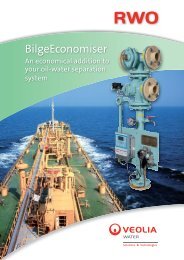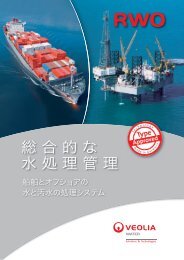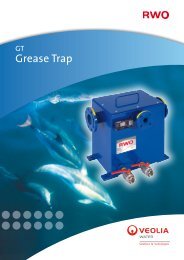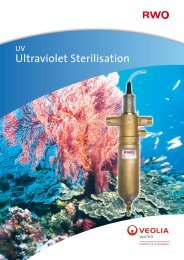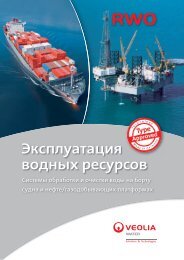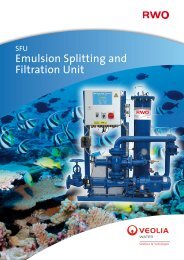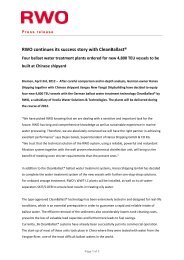the IHS Ballast Water Guide - RWO Marine Water Technology
the IHS Ballast Water Guide - RWO Marine Water Technology
the IHS Ballast Water Guide - RWO Marine Water Technology
Create successful ePaper yourself
Turn your PDF publications into a flip-book with our unique Google optimized e-Paper software.
Sponsored by <strong>IHS</strong> Fairplay Solutions <strong>Guide</strong> to <strong>Ballast</strong> <strong>Water</strong> Treatment Systems<br />
required efficacy. Biocide dosing level<br />
is variable and depends on ballast water<br />
conditions – <strong>the</strong> physical, chemical, and<br />
biological characteristics that, cumulatively,<br />
are called chlorine demand.<br />
The SiCURE system treats ballast water<br />
only on intake, allowing <strong>the</strong> system to be<br />
sized for ballast water flows while discharge<br />
can be done with higher flow rates. This is<br />
suitable for those vessels that use only one<br />
pump on intake and two pumps on discharge.<br />
Ozone<br />
(Mitsui) Special Pipe<br />
Hybrid 5 8<br />
The Special Pipe Hybrid system (Ozone<br />
version) from <strong>the</strong> Japanese shipbuilder Mitsui<br />
Engineering is a two-stage system based on<br />
cavitation by high shear and ozonation. In <strong>the</strong><br />
ballasting phase, water is taken into <strong>the</strong> pretreatment<br />
unit before passing to a unit that<br />
injects ozone, which has been generated on<br />
board, into <strong>the</strong> water.<br />
This method of treatment starts with<br />
inline pre-treatment to preventing blockage<br />
of <strong>the</strong> disinfecting unit followed by a more<br />
complex mechanical treatment via a “special<br />
pipe” which is inserted into a section of<br />
<strong>the</strong> normal ballast pipe run and <strong>the</strong>n ends<br />
by adding <strong>the</strong> produced ozone which is<br />
considered as an active substance by <strong>the</strong> IMO.<br />
After addition of <strong>the</strong> ozone to <strong>the</strong> water, for<br />
<strong>the</strong> treatment to be effective it is necessary<br />
for <strong>the</strong> ballast to be stored in <strong>the</strong> tank for at<br />
least 48 hours.<br />
This minimum amount of storage time is<br />
needed to allow for <strong>the</strong> strong oxidising and<br />
disinfecting properties of bromate, which<br />
is generated from <strong>the</strong> reaction of ozone and<br />
seawater, to become ineffective. The halflife<br />
period of <strong>the</strong> bromate ion is, on average,<br />
around 12 hours.<br />
A discharging unit decomposes <strong>the</strong> oxidant<br />
remaining in <strong>the</strong> ballast water at <strong>the</strong> time<br />
of discharge. The ozone generator contains<br />
multiple electrodes that convert a part of <strong>the</strong><br />
oxygen in <strong>the</strong> gas to ozone.<br />
A power supply unit converts <strong>the</strong> power<br />
type from commercial frequency and low<br />
voltage to medium frequency and high voltage<br />
most suitable to ozone generation.<br />
A gas/liquid separation unit is employed<br />
to prevent ozone that does not react from<br />
flowing into <strong>the</strong> ballast tank.<br />
© <strong>IHS</strong> Global Limited 2012 35<br />
012_037_CorrectedBW1204.indd 35 01/08/2012 15:37:34



